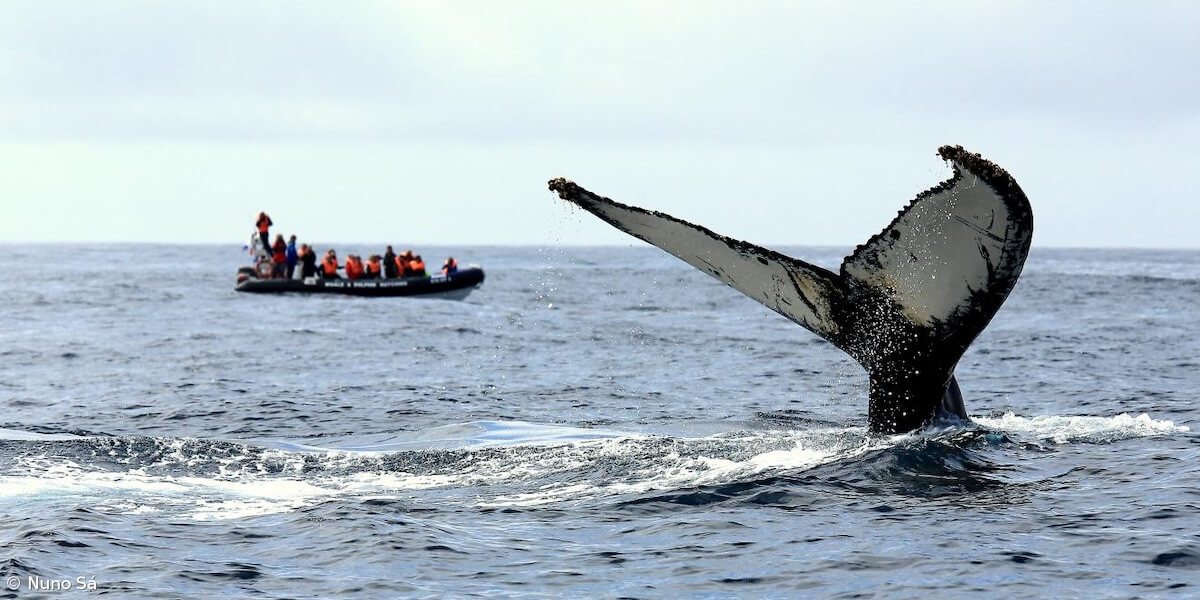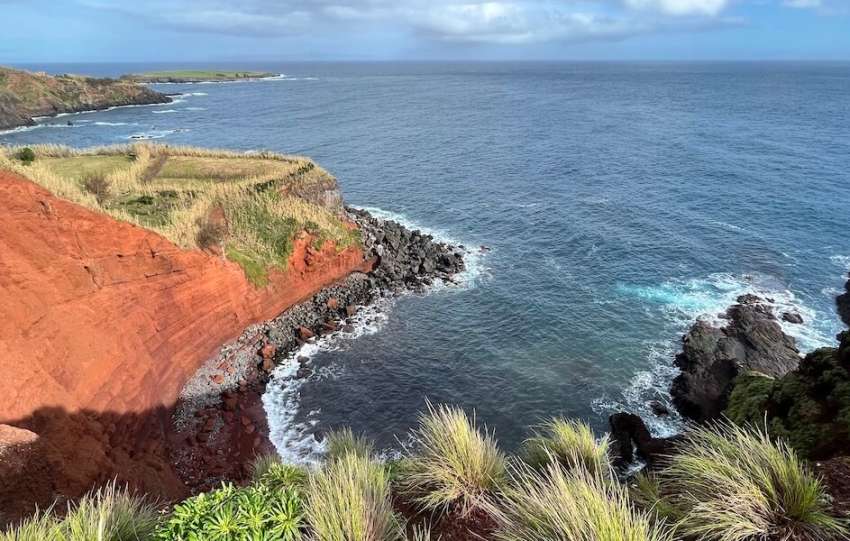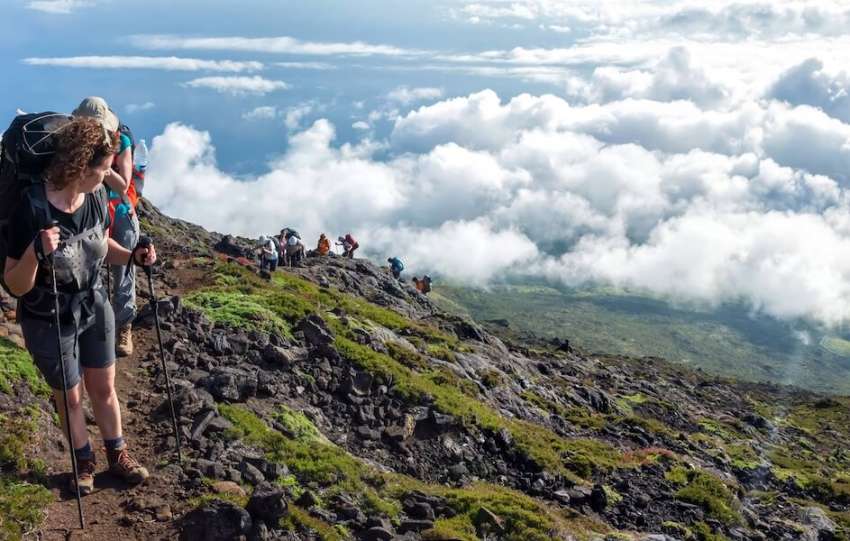Share This Article
Whale watching in the Azores is a must-do for nature lovers and adventure seekers.
Located along migratory routes, the Azores islands are a vital habitat for various whale and dolphin species, making it one of the best places to watch these majestic creatures.
In this article, we’ll explore the best times to go whale watching, the diverse species you might encounter, and the top locations and tours to enhance your experience in this marine paradise.
No time for a long article? Here’s a summary
Best time of the year to do whale watching in the Azores: Spring.
Best islands to do whale watching activities: São Miguel, Pico, Terceira and Faial.
Best whale watching tours:
São Miguel: From Ponta Delgada: Whale and Dolphin Watching Trip, Azores: Whale Watching and Islet Boat Tour and the São Miguel Azores: Half-Day Whale Watching Trip.
Terceira: Terceira: Whale and Dolphin Watching in a Zodiac Boat and the Terceira: Half-Day Dolphin and Whale Watching Tour.
Pico: Pico Island: Azores Whale & Dolphin Watching on a Zodiac Boat.
Average duration: 3h.
Average price: 60€ / adult, 35€ / kid. Yep, it’s expensive.
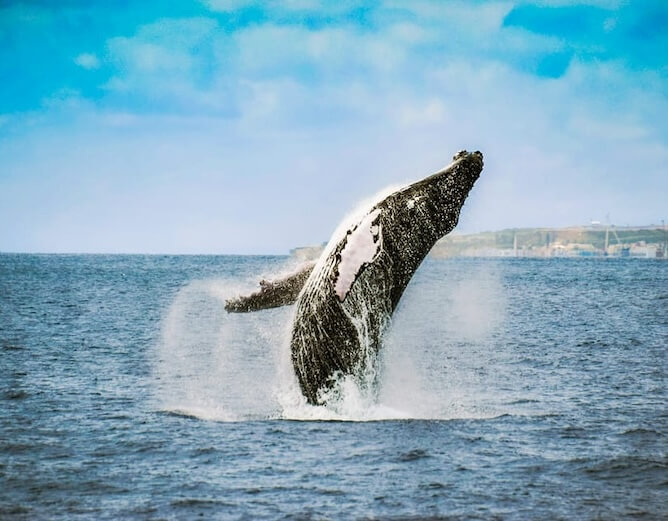
Best time for whale watching in the Azores
Whale watching in the Azores offers unique opportunities throughout the year, thanks to four resident species that can be spotted at any time: common dolphins, bottlenose dolphins, Risso’s dolphins, and sperm whales.
Spring (April to June) is the prime season for spotting large whales. During this time, migratory giants like blue whales and fin whales pass through the Azores on their journey from tropical breeding grounds to feeding areas off Greenland, Iceland, and Norway. The waters are rich in plankton and krill, providing a feast for these mammals, making it an ideal time for whale watching.
In summer (July to September), as water temperatures rise new migratory species arrive, including Atlantic spotted dolphins, striped dolphins, and pilot whales. This season is particularly interesting as many young dolphins can be seen swimming alongside their mothers in large groups.
Autumn (October to December) continues to offer sightings of Atlantic spotted dolphins, who enjoy the warm waters until temperatures drop. The resident species remain active, with sperm whales still frequenting the islands.
During winter (January to March), whale watching is dependent on weather conditions. Although challenging, it’s still possible to see the resident species, including sperm whales and common dolphins. In any case, I really don’t recommend visiting the Azores Islands in the winter!
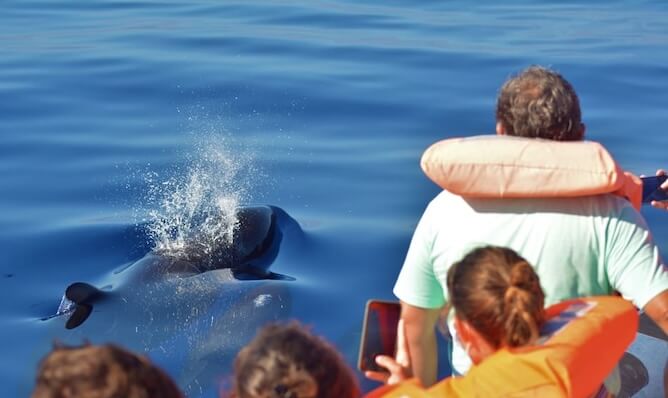
Types of whales and dolphins found in the Azores
Did you know that of the 81 species of whales and dolphins that exist worldwide, it is possible to see up to 28 of them in the Azores alone? That is why it is the best European destination for whale watching. True story.
I am not a biologist, so I found this really interesting table of the most commonly found species in the Azores, for each month of the year, published by Futurismo:
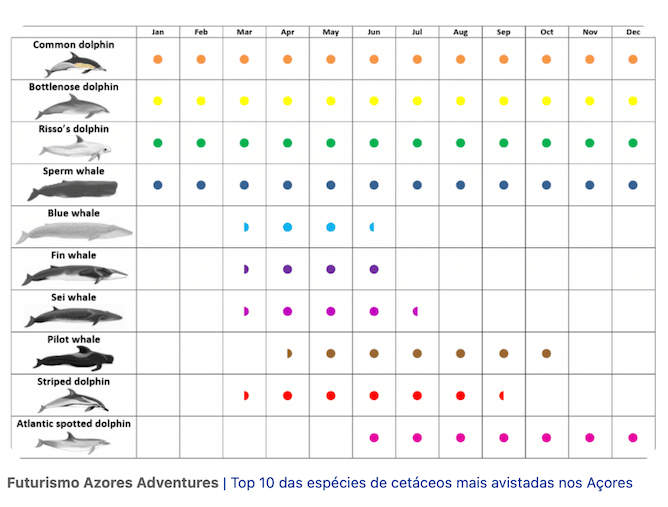
Top whale watching locations in the Azores
The Azores offers several prime locations for whale watching, each with its own unique features and advantages. Here’s a comparison of the four top islands for whale watching in the Azores: São Miguel, Pico, Faial, and Terceira.
1. São Miguel
The largest and most populated island, São Miguel is a hub for whale watching in the Azores. Its strategic location along migratory routes makes it an ideal starting point for spotting species like sperm whales and dolphins.
Additionally, São Miguel boasts several experienced tour operators, offering diverse options for whale watching, from traditional boat tours to more eco-friendly experiences. It is also the island where you will get the best rates.
Unique Features:
- More tour options
- More competitive rates
- One of the few islands with direct flights from the USA and Portugal
2. Pico
Pico Island, known for its towering volcanic peak, is often regarded as the whale watching capital of the Azores. The waters surrounding Pico are teeming with marine life, and its rich history of whaling has fostered a deep respect for these creatures. So much that they have not one but TWO museums dedicated to the whaling industry!
Pico also offers opportunities for both boat and land-based viewing, making it a versatile destination for whale enthusiasts.
Unique Features:
- Highest chance of spotting large whales
- Strong focus on conservation and education
- Stunning views of Mount Pico and surrounding landscapes
3. Faial
Faial Island, often referred to as the “Blue Island” due to its vibrant hydrangeas, is another excellent spot for whale watching in the Azores. The island’s proximity to Pico enhances the whale watching experience, as many tours operate between the two islands.
Moreover, the charming town of Horta serves as a popular base for travelers, offering a lively atmosphere and essential amenities.
Unique Features:
- Close proximity to Pico for combined tours
- Charming harbor town (Horta) with a vibrant sailing atmosphere
- Great opportunities for both whale watching and exploring local attractions
4. Terceira
Terceira Island is often overlooked but offers a unique whale watching experience. With fewer crowds and a more laid-back atmosphere, Terceira provides a tranquil setting for observing marine life.
Moreover, Terceira Island has direct flights from the USA and from continental Portugal.
Unique Features:
- Less crowded, providing a more peaceful experience
- One of the few islands with direct flights from the USA and Portugal
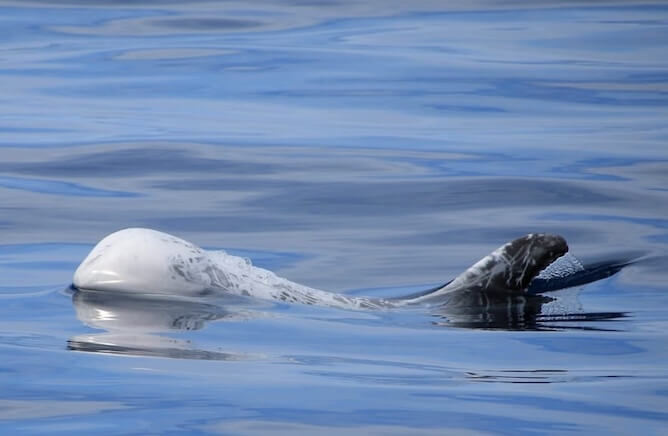
Whale watching Tours and Operators
I have found great tour operators for whale watching in different islands in the Azores. These are the ones I recommend:
1. São Miguel
- From Ponta Delgada: Whale and Dolphin Watching Trip – this is by far THE tour operator I recommend the most. Indeed, Futurismo’s team is made up of marine biologists who are not only deeply knowledgeable about the marine species you will see but are also aware of the best animal welfare practices.
Price: 65€ / adult, 32,50€ / child.
Tickets: Make your online reservation. - Azores: Whale Watching and Islet Boat Tour: another fantastic tour operator, that has been conducting whale watching expeditions for the past 20 years. One thing that I don’t like is that they charge substantially more for children’s tickets than the other tour operators.
Price: 62€ / adult, 45€ / child.
Tickets: Make your online reservation. - São Miguel Azores: Half-Day Whale Watching Trip: if the previous two operators are sold out, then I recommend you this one. It has the advantage of being cheaper AND providing pick up in both Ponta Delgada and Rabo de Peixe.
Price: 60€ / adult, 30€ / child.
Tickets: Make your online reservation.
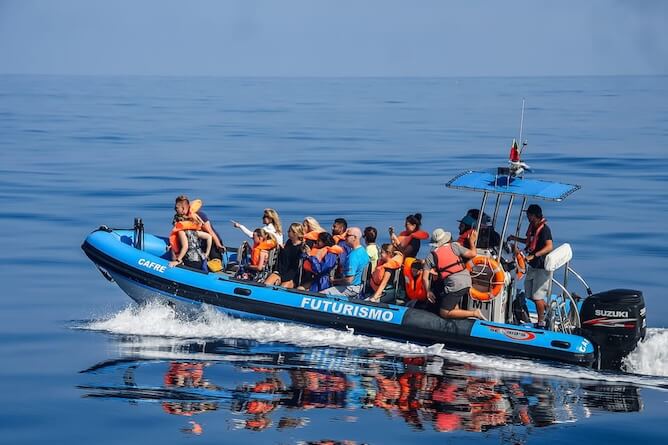
2. Pico
- Pico Island: Azores Whale & Dolphin Watching on a Zodiac Boat. Unfortunately, in Pico there are not as many options as on the island of São Miguel. However, there is a very good operator, which is essentially a family business that has been around for almost 30 years. This tour departs from Lajes do Pico.
Price: 65€ / adult, 40€ / child.
Tickets: Make your online reservation.
3. Terceira
- Terceira: Whale and Dolphin Watching in a Zodiac Boat. This is the most popular tour operator in Terceira Island.
Price: 65€ / adult, 32,50€ / child.
Tickets: Make your online reservation. - Terceira: Half-Day Dolphin and Whale Watching Tour. If the previous tour operator is not available, this is a solid substitute.
Price: 60€ / adult, 30€ / child.
Tickets: Make your online reservation.
4. Faial
Faial is one of the smaller islands in the Azores and this is reflected in the (few) number of tour operators. I only know of one with good references, and it is much more expensive than on the other islands.
Horta: Whale and Dolphin Watching Expedition
Price: 90€ / adult, 80€ / child.
Tickets: Make your online reservation.
So, unless you REALLY want to do whale watching on the island of Faial, I recommend that you leave this activity for São Miguel, Pico or Terceira, where you will find the same service at much more attractive prices!
What to expect on a whale watching tour
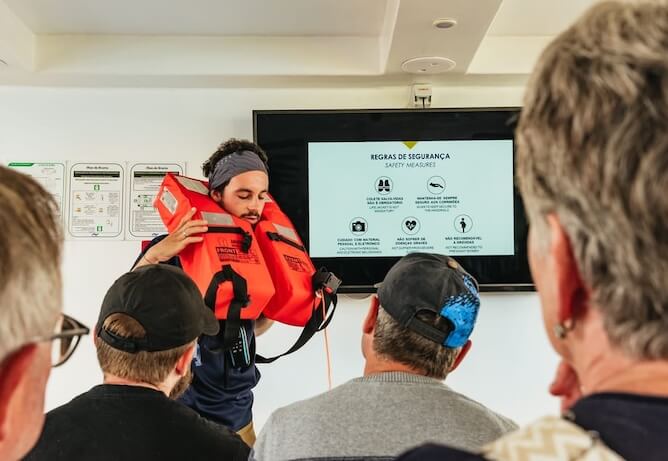
Typical Duration and Itinerary
Whale watching tours last between 3 to 4 hours, and this is the layout of the experience:
- Departure: Tours usually start from the main ports on the islands, such as Horta (Faial) or Ponta Delgada (São Miguel). You’ll check in, receive a safety briefing, and meet your guide.
- On the water: Once you’re out at sea, the crew will scan the horizon for signs of marine life. They will share information about the species you might encounter and the unique features of the Azorean marine ecosystem.
- Sighting: When a whale or dolphin is spotted, the boat will approach carefully, ensuring you maintain a respectful distance. You’ll have plenty of opportunities to take photos, don’t worry!
- Return: After the tour, you’ll head back to the port, discussing your experiences with fellow travelers. It’s quite nice :)
What to Bring
Here’s what you should bring along:
- Clothing: the best strategy is to dress in layers, because the weather in the Azores is VERY temperamental and it can quickly change from sunny and pleasant to windy and wet. Wearing multiple layers allows you to adjust to these changes. Start with a base layer that wicks moisture away to keep you comfortable. Add insulating layers for warmth, and top it off with a waterproof jacket to guard against spray and rain.
- Footwear: if you don’t want to sound like a grumpy old man on the boat, choose your footwear WISELY! Go for waterproof boots with non-slip soles. Such footwear offers traction and protection, allowing you to move safely around the boat while keeping your feet dry.
- Camera: Don’t forget your camera or smartphone to capture the incredible moments! Bring a lens with good zoom capabilities to get close-up shots of the whales and dolphins without disturbing them. Consider using a waterproof case if you plan to take photos near the water.
- Sunscreen and Sunglasses: Protect yourself from the sun’s rays, especially during the warmer months. Apply sunscreen before you board, and wear sunglasses to shield your eyes from the bright reflections off the water.
- Snacks and Water: it’s a good idea to bring your own water and light snacks to stay energized throughout the trip.
Responsible whale watching practices
Here are some key guidelines for respectful whale watching in the Azores:
- Choose Responsible Tour Operators: Select companies that follow ethical whale watching practices, such as maintaining a safe distance from the animals. Look for operators certified by recognized environmental organizations.
- Respect Wildlife: Keep a respectful distance from whales and dolphins. Avoid any actions that could disturb or stress the animals, such as loud noises, sudden movements, or attempts to touch them.
- Stay Calm and Quiet: Keep noise levels to a minimum while observing marine life. Loud sounds can startle or disrupt the animals, affecting their behavior.
- Do Not Feed or Swim with Marine Life: Feeding whales and dolphins disrupts their natural foraging behavior and can lead to dependency on humans. Swimming with wild marine animals can also pose risks to both the animals and humans involved.
- Educate Yourself and Others: Take the time to learn about the species you might encounter and the importance of their conservation. Share this knowledge with fellow travelers to promote greater awareness and respect for marine life.
Conclusion
So, there you have it! The Azores truly stand out as a premier whale-watching destination, offering stunning views and incredible marine life experiences.
If you’re looking to witness the majesty of whales and dolphins in their natural habitat, there’s no better place than here. Whether you’re gliding over calm waters in search of magnificent blue whales or enjoying the playful antics of dolphins, every moment in the Azores promises to be unforgettable.
So grab your gear, book that tour, and get ready for an adventure that you’ll be talking about for years to come!

